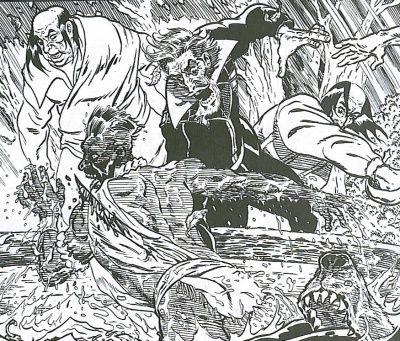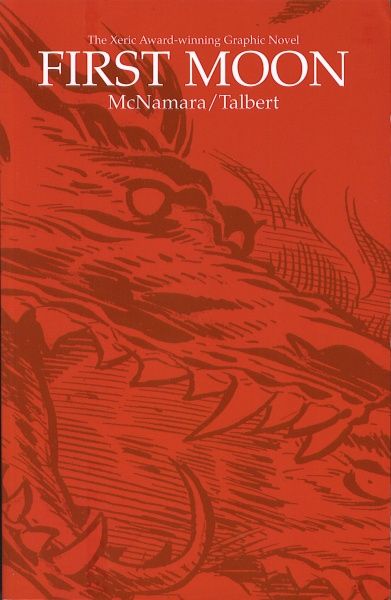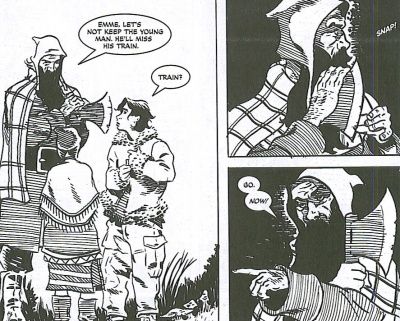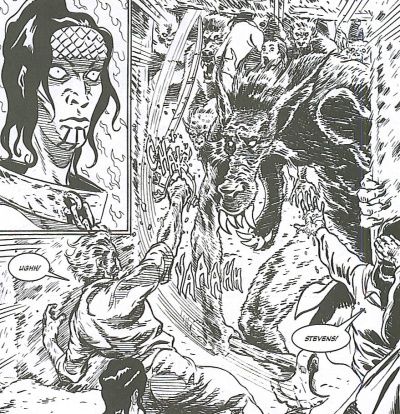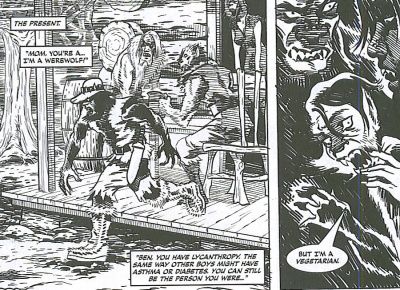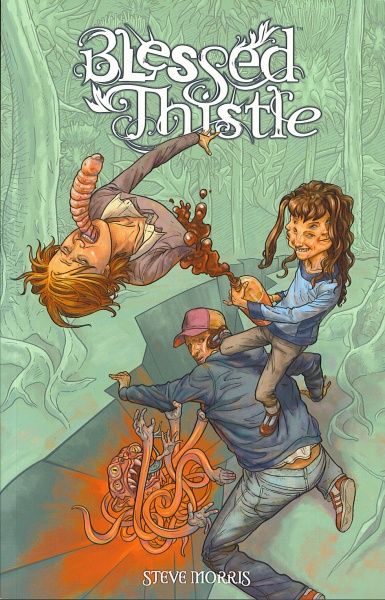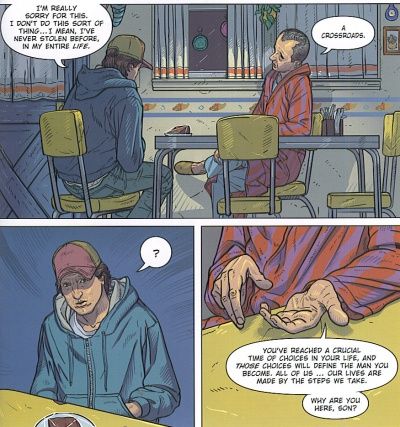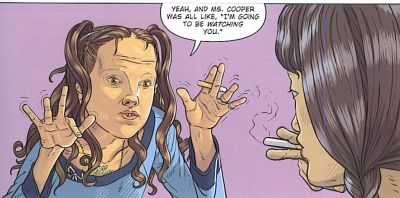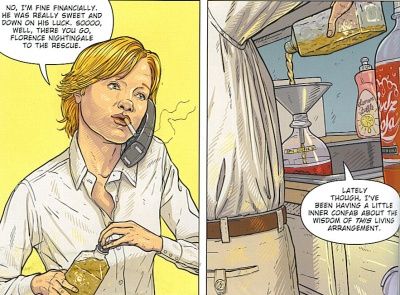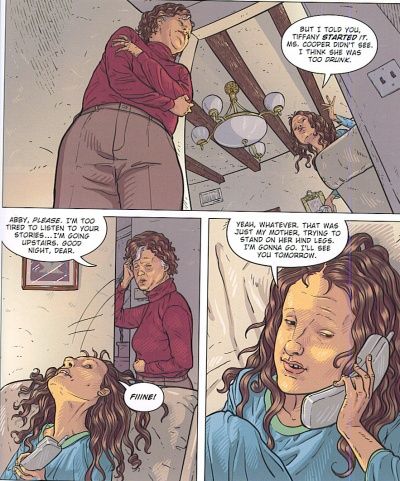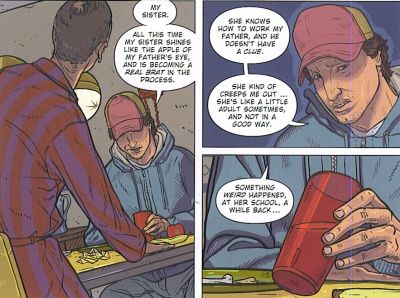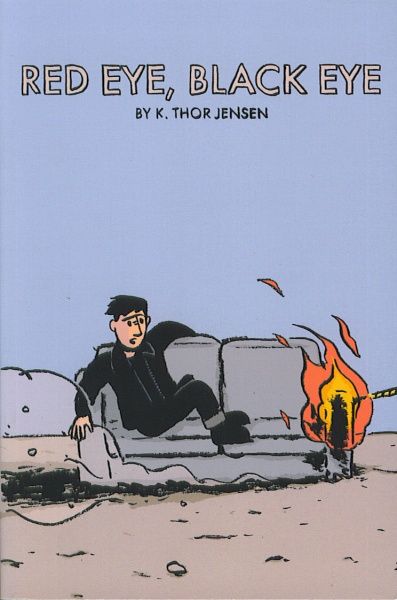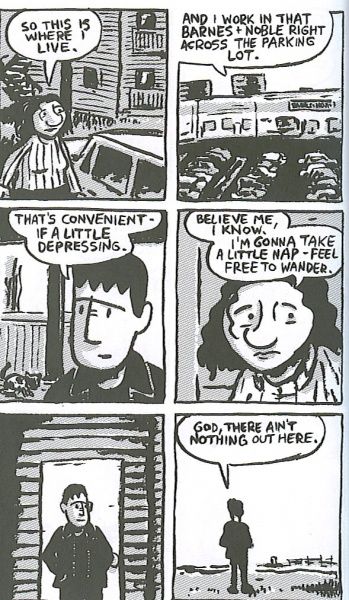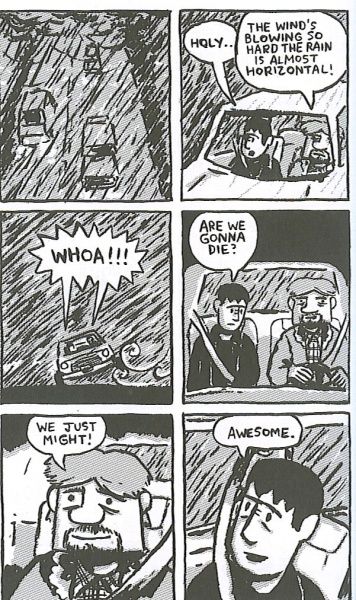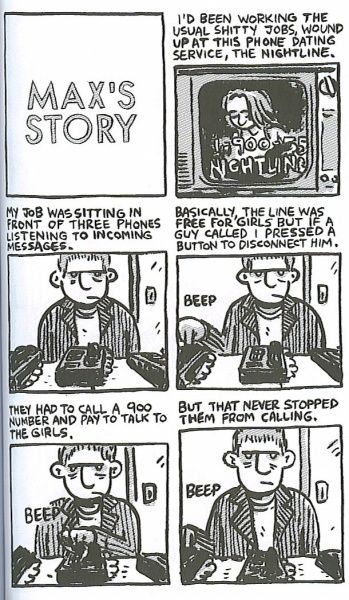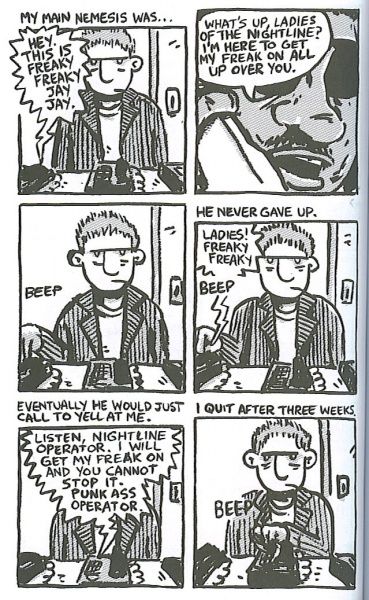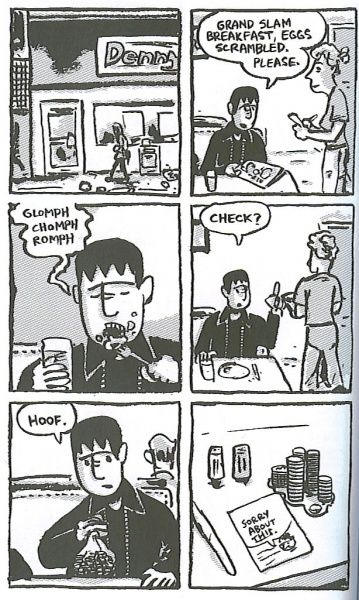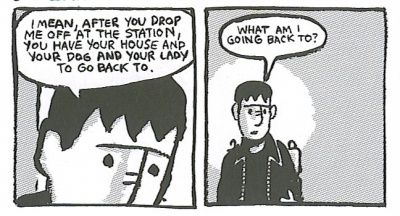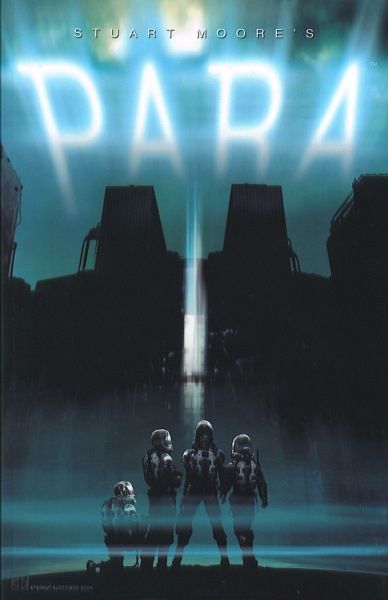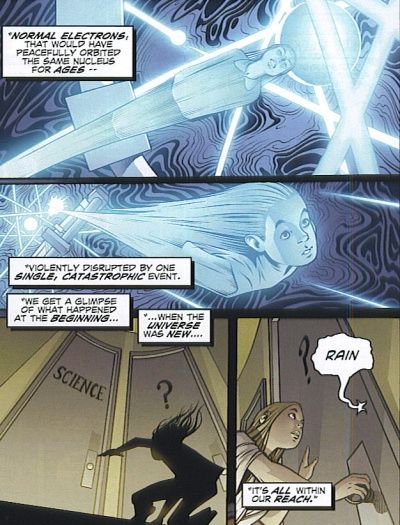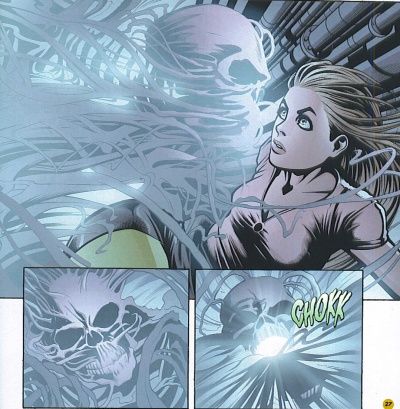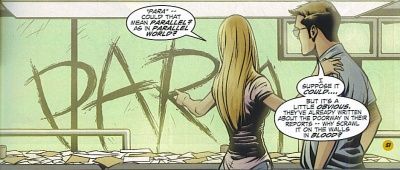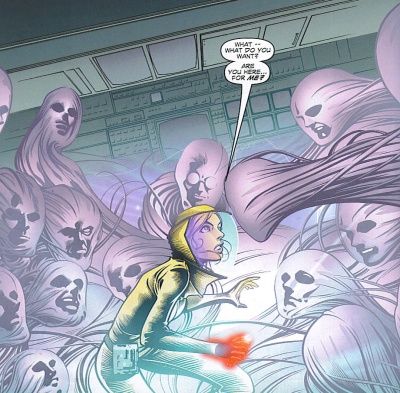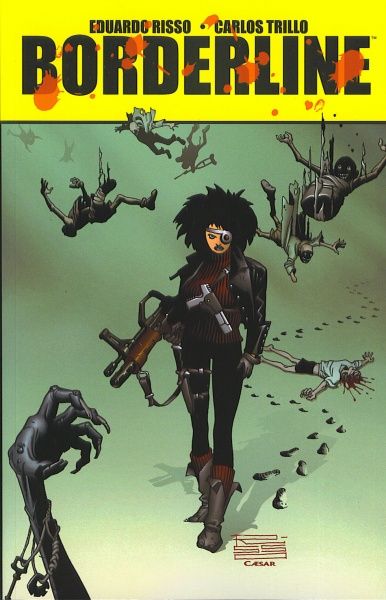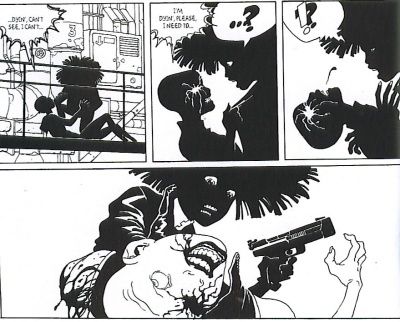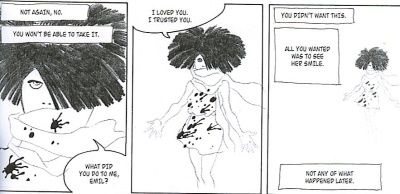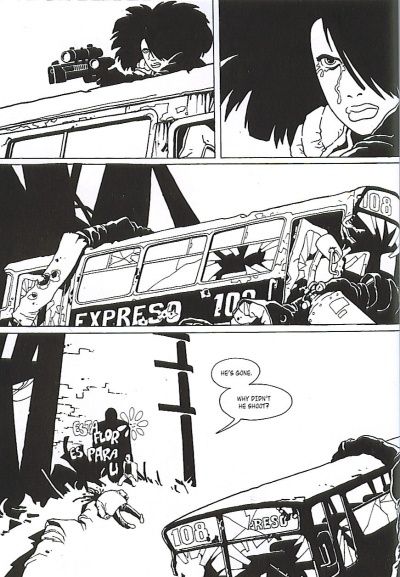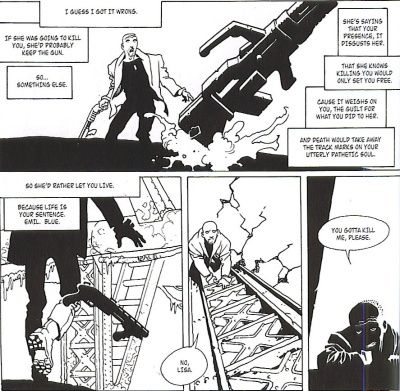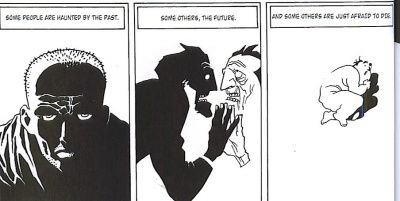Yes, it's time to review a bunch of original comic book novels and collected editions that I have bought recently. I'll try to be brief, although you know with me it's never easy!
Some SPOILERS ahead, in case you're wondering. But only if it's obvious what's going on in the first place!
First Moon is written by Jason McNamara and drawn by Tony Talbert and is published by the fine folk at AiT/Planet Lar. It costs $12.95.
I bought this, and then Larry sent it to me, for which I thank him, but now I'll have to have another contest! But that's down the road. First, isthe bookany good?
That depends. This book has one thing I like - historical mystery - and another thing that I like occasionally but get burnt out on often - werewolves. So that becomes a problem. If you like both of those aspects, you'll probably enjoy this a lot. The idea is certainly interesting - McNamara and Talbert set out to explain the mystery of why the Roanoke colony disappeared in 1587, and it has nothing to do with the Sheeda, you'll be happy to know. It turns out that the natives around there had a big secret, and they appeared one night and devastated the settlers in order to rescue one of their own, who was taken captive. This story from the past is tied into a story in the present, in which a young boy discovers that he too is a werewolf and must make a harrowing journey to the island, where he learns many secrets about who he is.
The first thing I noticed in the book is the art. Talbert's work is unusual and looks off somehow, but it works for the project. The way it's "off" is that the people in the book are strangely grotesque, just enough different from the way we expect people to look that they take on a slightly sinister appearance. In the present, Ben (the boy) and his friends are the most normal, but in the past, everyone has elongated foreheads and faces, and they're always contorting in strange ways. His werewolves are particularly horrific, with scoop jaws that are much longer than normal, with twisted limbs and teeth too large for their mouths. It's unnerving and fascinating at the same time, and creates an atmosphere of spookiness throughout the entire book. His details are fantastic, too, especially at the end, when the werewolves attack the colony.
Ben's journey is less interesting, because although some exciting things happen to him along the way, it still lacks the tension of the historical part of the book. In 1587, the colonists capture an Indian woman and chain her in a hut, and she subtly influences them as they wait for rescue from England. Psychologically, it's a gripping story. The natives become more and more uneasy, there is a constant threat of Indian attack, and the final assault, which is full of violence and brutality, hits both the settlers and the reader hard but effectively. Meanwhile, in the present, Ben runs away from home when he sees his parents as werewolves and ends up on the island, where he must accept what he is, but it's a bit lacking in the execution. It's more than likely that because I have another, better story to compare it to, I'm shortchanging it. There's nothing wrong with Ben's story, but compared to the story of Roanoke, it falls short slightly, especially the ending, which is pretty much what we expect to happen. Ben's story is more heartwarming, because it's a tale of a boy coming to terms with who he is, something we can all relate to, but it's not as gripping.
There's a great deal to like about First Moon. Despite my reservations about werewolf stuff, the nice thing about this is that the werewolves don't take over the story, they're simply part of it. When Ben reaches the island, the werewolf stuff becomes more interesting because of what he finds there. So my interest in historical mysteries overwhelms my lukewarm reaction to the "horror" aspects of the books (hey, at least they're not frickin' zombies!), and this becomes a neat comic book.
Blessed Thistle is written and drawn by Steve Morris and is published by Dark Horse. It costs $9.95.
Blessed Thistle is kind of a horror comic, but the best kind of horror comic: it involves nothing supernatural at all, but simply shows how horrific "normal" people can be. This is the kind of book I was hoping Gotham County Line would be, because it doesn't rely on external things to make our skin crawl. There's a bit with a worm, but that's the least effective part of the book.
Morris' art fits the subject matter perfectly: it's odd, very detailed and precise, normal-looking yet subtly disturbing. The only real problem with it is that Abigail, who is the protagonist of one of the stories in the book, looks far too old to be in seventh or eighth grade, where she's supposed to be. Her brother at one point says she's more like an adult than a child, but she shouldn't look that way! Other than that, the art is very good. It, like a lot of the book, gets under your skin and makes this book a creepy read.
The stories are slice-of-fucked-up-life stories, and they all connect in some way. We begin with a kid breaking into a typical suburban house, where he's surprised by the owner, a kindly ex-minister, who invites him to sit down and have some cake. They talk about the kid's life and how shitty it is, and throughout, we get a strange vibe, like the minister couldn't really be this nice. Well, we'll see about that. The boy tells the minister about his sister, Abigail, who is a spoiled brat and is turning into something worse. The story shifts to Abby, who is a horrible child, and her confrontation with her teacher,Jen Cooper. We also get a bit of Ms. Cooper's home life, which is typically boring - she is single and lonely and drinks a bit too much, a fact that Abby discovers and uses to her advantage. The story continues to peel away these characters until we reach the middle, which concerns a worm in a laboratory. Then we come back out, getting the resolutions to each vignette, with each one more disturbing than the last. The stories are about the true evil that lies in the heart of humanity, which is why this book is a lot more disturbing than your typical horror comic. There are no zombies or werewolves or vampires to pin everything on here!
Morris does a good job revealing character through everyday dialogue. Jen Cooper is talking on the phone to a friend about Abby and moving through her house, and we see her whole life in miniature. As Murry (the pastor) and Skip (Abby's brother) talk, we understand more and more about why each one has come to this point, although the actions of one of them remain inscrutable. This book is about power and the lack of it, and who really wields it in society and how they abuse it. Does Jen Cooper have power over Abby, or is it the other way around? Why do people in this book do horrible things? Morris, wisely, never answers that particular question, but it's worth asking and pondering.
The only real problem I had with the book is that the characters are related so closely. Skip gets involved in a creepy situation, and it just so happens that his sister is also quite an evil child. Jen Cooper is involved in a situation with Abby, and it just so happens that the worm in the laboratory has a profound effect on her life. I don't mind that all these things take place in the same suburb, but it would have bugged me less if they weren't so closely related. It's a minor annoyance, though, because it only serves to link the stories. Plus, Skip's situation and Abby's kind of mirror each other, so it's fitting they're brother and sister. The coincidences vaguely bugged me, though.
Other than that, this is a neat comic. It confronts us with things we'd rather not think about, and makes us wonder what's going on inside the charming houses and schools of that bastion of normalcy, suburban America. A very unsettling but powerful book.
Red Eye, Black Eye is written and drawn by K. Thor Jensen and is published by Alternative Comics. It costs $19.95.
Perhaps the most fascinating thing about Red Eye, Black Eye is how unsympathetic Jensen, who's the narrator, is for most of the book. He's not exactly unlikable, but he does come off as a dick in some situations, yet it actually helps us toward the end, when he begins to be less of a dick. (And it's not that I didn't like him, it's just that he acts like a jerk a lot.) There's a danger in portraying your main character as less than a swell guy in a story like this (even though it's a true story - I assume - a writer can still edit the past!) because the reader might get turned off before the change in attitude, but the events that are going on around Jensen help us keep going, because the rest of the book is interesting.
Jensen tells a story about his journey across the U. S. with a Greyhound Ameripass following September 11th. He decides to become a self-appointed hobo, and he travels the country for two months visiting people he has "met" on the Internet. As he goes, he asks them to tell him stories, and it's these stories that form the meat of the book. Part of the problem with Jensen for much of the book is that the people he meets are far more interesting than he is. We don't want to follow him; we want to stay with the people he meets! But as he listens to them, he becomes much more comfortable with himself and with his situation. He bemoans the fact that he didn't really glean much insight into America after the bombings, but this book isn't really about that, and what Jensen learns is far more important for his life than how Americans are dealing with the trauma of a terrorist attack.
Jensen loses everything at the beginning of the book - his job, his girlfriend, his apartment, and his grandmother. He watches the towers fall from his balcony. He has nothing to do, which is what spurs him on. The people he meets aren't a very good cross-section of Americans - they're mostly young, white, computer-literate ... you know, nerds! But they have a wide range of stories to tell Jensen, some poignant, some surreal, some pointless, some very funny. Even the most ridiculous ones (the guy taking his rabbit pelts out of washing machine at a local laundromat, to pick one) add a nice sense of texture to the experience that Jensen is going through. Each story, which are only 1-2 pages long, is about celebrating what makes us human. And therefore, in a roundabout way, they're about celebrating the human spirit in the aftermath of the terrorist attacks. It's a wonderfully subtle way of showing how indomitable people are in the face of tragedy. There are only a few references to September 11th, which is nice, because we're aware that it's there in the background, but the people that Jensen meets help him understand that we refuse to be defined by tragedy. We'd rather be defined by those goofy little moments that make us different from everyone else, no matter how similar we seem. Whether it's the girl whose ex-boyfriend had a birth defect that gave him a divot in the middle of his ribcage, in which he would put candy while they watched movies, or the guy who tries to pot at a mall and gets screwed out of both his money and his drugs, the stories help us understand how we deal with tragedy and how we move past it. By the time Jensen returns to New York, he may not think he's learned anything, but his attitude has definitely changed.
Jensen answers his own questions about his journey. At one point, a woman on the bus asks him where he's going, and Jensen answers that he's heading to the same place he started from, eventually (it's a round trip, after all). Amanasks, "Shit, why didn't you just stay there?"Jensen looks downcast and says, "You know, Idon't really have an answer for that." Late in the book, he is talking to a friend and he says, "I thought I'd be coming to great realizations about the natureof post-terrorist America andhuman life ... I thought I'd go home a changed man, rich with wisdom and hope. Instead my back hurts and I'm greasy." Jensen doesn't recognize that he's changed, but we do, and that's what counts, at least for this book. He couldn't stay in New York, even though he's going back there eventually.RedEye, Black Eye trulyembodies the idea that thejourney is the key, not the destination.
If I knew more about art, I would talk more about it. But I don't, so I won't. It fits the book nicely.
Jensen's story makes uswonderabout how we fit into our societyand how we come to grips with things that are out of our control. It's a nice comic with a lot of fun moments and a lot of moments to ponder.
Para is written by Stuart Moore and drawn by Pablo Villalobos, Claude St. Aubin, Federico Zumel (pencillers) and Mostafa Moussa and James Taylor (inkers) and is published by Penny-Farthing Press. It will cost you $19.95.
There's so much to like about Para (or Stuart Moore's Para, to give it the official title) that the fact that it's a bit disappointing at the end is very frustrating. The set-up is cool, but the resolution isn't. Of course, your mileage may vary.
Deep underneath Texas, Dr. William Erie is building the world's largest particle accelerator. He wants to discover the secrets of the universe, never a good thing in comic books - something is sure to go wrong. Sure enough, during their first trial, there's an accident, and radiation floods the complex, killing everyone. Twenty years later, Dr. Erie's daughter Sara returns to Texas because the radiation has dissipated in order to find out exactly what went wrong and what happened to her father. She meets on old friend of her father's, Dr. Jonas Sandersen, who fakes credentials for her to get her on the team that is going down into the complex. They are joined by Roger, Dr. Sandersen's grad student, who has a history with Sara, and Agent Donna Sanchez, who represents the government. That can't be good. When they reach the facility, there's no traces of radiation, they find frogs trapped in crystals, and the word "Para" is written in blood on the walls. Sara comes across a ghost-like creature, which understandably freaks everyone out. Sanchez calls in a Dr. Zakaraius, who is, in Dr. Sandersen's words, a "UFO nut." Sanchez thinks there's something more going on down in the accelerator than science can explain. They all head back down into the facility. Bad things happen.
The idea is intriguing, and Moore adds onto this by delving into the origins of the universe, parallel dimensions, and some good old-fashioned government conspiracy just for the heck of it. The bad guy turns out to be rather unexpected, which is nice, and there's a good deal of action and adventure as the explorers try to figure out what happened. This has all the ingredients of a horror/sci-fi/thriller classic, but Moore can't quite pull it off. He follows the horror movie template of death a little too closely. You know how you can always tell who's going to die when a group of people get stuck in a horror flick? I'm not going to spoil anything, but when this group goes underground, we can pretty much guess who's not coming back. It's frustrating. In the end, Moore explains everything a bit too cleanly. It's actually an intriguing resolution to the problem, but I got the feeling that it was a bit too neat. Some things, perhaps, should have been left unexplained, to keep that feeling of mystery throughout. In his zeal to explain everything, Moore takes out a lot of the tension of the set-up, which is a shame.
The art is standard superhero style, which is fine. For the most part, it's nice and detailed, and the scenes of the particle accelerator itself are done well, giving us a good sense of claustrophobia and technology. The ghost creatures are also rendered nicely. They have a good ethereal quality throughout, and given what they are, that's a good thing. We get a good sense of the characters through their facial expressions, and a lot of their emotions are conveyed through the art, which means Moore doesn't have to overwrite a lot. I assume Villalobos did the early issues (it's a collected edition of a six-issue mini-series), and it's a shame he didn't do the whole thing, because the early issues are much more detailed and kinetic, even though the two other artists try to ape the style set early on.
Despite my disappointment with the "too-much-explanation" ending, Para is an enjoyable read with a nice premise that is unlike a lot of stuff out there. For a long time, it's creepy and suspenseful, and there are enough surprises (not who dies, as Iwrote, but in other areas) to keepthe pages turning. The endingis logical (for a comic book) and comes organically from the story, butI just wish there had been lessexplanation. Other than that, it's a fun book.
Borderline (volume 1)is written by Carlos Trillo and drawn by Eduardo Risso and is published by Dynamite Entertainment. It costs $19.99.
Borderline is the work of two Argentinian comics creators, one who should bewell known from his work on 100 Bullets, the other who has been around for a long time but is probably not well known in this country. I don't know howmany volumes there willbe, but this is a good start.
Risso's artworkwas the draw for me, and it doesn't disappoint. Everythingwe've come to expect from 100 Bullets is here, from the twisted and grotesque people to the hauntingand slightly surreal landscapes to the bizarre camera angles. He brings atypical dystopian future tolife by remembering that even in the future, there will be slums. There is a great deal of decadence in this book, because it's a standard "the-rich-rule-everything" kind of future, and Risso does a nice job showing the seediness of the rich even as they live in opulence.Heshows the contrast between the rulers of society living in splendor even though that splendor is insidebunkers where they are forced to reside. Similarly, he gets the sense of despair and degredation in the slums.In the flashback scenes, he softenshis pencil a great deal, which does a good job evoking an age of innocence, especially becausethe flashbacks mainly concern two lovers for whom things go horribly wrong.
Trillo'sframework for the story is nothing special, as we get the future where everyone is a "have" or a "have-not." The middle class is always the first togo when the future goes badly, I guess. There isone interesting idea he brings us: the Void. Early on,the main character, whom we'll call Lisa even though she no longer goes by that name, drives to the Hill, where the Earth is separated from the Void. People in despairgo there to commit suicide byjumping. Lisa is fascinated by the Void but not suicidal enough to jump. The Void never shows up again in this volume, but it's a strange little twist in the book that cries out for more involvement. Lisais an agent for the Council, one of the tworuling groups in the book. TheCommune is the other, and the two are in constant competition for ascendancy. One of the Commune's agents, Emil, is Lisa's former lover. As the story unfolds, we learn thereason why they're not together anymore, and it's a pretty horrific story, and we also watch as the Council and the Commune engage in a game of one-upmanship that brings Lisa and Emil into direct confrontation with each other. That, of course, is the climax of the book.
What works best in the book is the way Trillo manipulates his characters into the final confrontation. Everything moves along with a kind of terrible inevitability, but we need feel like it's forced on us in any way. Lisa and Emil are doing their jobs, and Lisa knows that Emil works for the Commune but Emil doesn't know that Lisa works for the Council. Therefore, we get a bit more of what Lisa is thinking, because she can feel a meeting coming, while Emil remains in the dark for most of the book. It's a nice juxtaposition that Trillo sets up, and as the secrets of their past relationship come out, we get a better understanding of why neither of them really wants the meeting but why both of them probably need it. As we expect, lots of violence is involved when they do meet, and it doesn't go all that well. It's a dystopian future, remember!
The book, strangely, doesn't end with the story of Lisa and Emil. Two short stories follow it, which feels weird because thematically they don't fit with the rest of the book. They're good stories, and they bring a few of the secondary characters more into focus, but it's just odd that they're in this collection. I suppose there will be more volumes, so I wonder why they couldn't fit them in the next one. It's no big deal, just a bit strange.
This is a good read. Trillo does some interesting things with the idea of a future gone mad (especially when it comes to Lisa and what happened to her), and Risso's art is fantastic. The book is in black and white, and I wonder if 100 Bullets would look even better without color. Here you get to see what that book might look like if it was black and white. Very neat. If you like love stories set in a decidedly screwed-up future, check it out!
All of these books are available on-line, so if you're interested in them, there's no reason to not check them out! Don't be a DC/Marvel slave!

